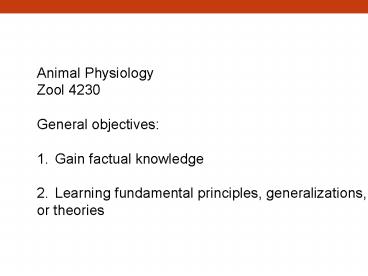Animal Physiology, Chapter 1 PowerPoint PPT Presentation
1 / 45
Title: Animal Physiology, Chapter 1
1
Animal Physiology Zool 4230 General
objectives 1. Gain factual
knowledge 2. Learning fundamental
principles, generalizations, or theories
2
Study of physiology
Physiology is the study of life processes
How living systems work, from the molecular
level to organ systems and to the whole
organism How the organism responds to
physical activities and to the environment around
it, whether it is the vacuum of space or the
depths of the ocean How disease can affect
living systems How the genome translates
into function both within the cell and the whole
organism
3
Table 1.4
4
Introduction
- Comparative physiology
- Environmental physiology
- Evolutionary physiology
5
Figure 1.17 The comparative method
6
Figure 1.12 Performance in an oxygen-poor
environment
7
Migrating Pacific salmon
8
Survival need
- Goal- to maintain life
- Need
- Nutrients
- Oxygen
- Water
- Maintain body temperature
- Atmospheric pressue
9
Figure 1.1 The study of physiology integrates
knowledge at all levels of organization (Part 1)
10
Figure 1.1 The study of physiology integrates
knowledge at all levels of organization (Part 2)
11
Physiologys two central questions
- Origin why do modern-day animals possess the
mechanisms they have? - Mechanism how do modern-day animals carry out
their functions?
12
The Study of Origin
- Why do modern-day animals possess the mechanism
they have? - Products of evolution
- The study of evolutionary origins reveals the
significance of mechanisms - Reliance on indirect reasoning very rarely
understood
13
Key process of evolutionary origin
- Natural selection- increase in frequency of genes
that produce phenotypes that improves an animals
chances of survival and reproduction within the
environment - Adaptations- aid the survival and reproduction
- Adaptive significance evolved by natural selection
14
Figure 1.4 Structures similar in performance
adaptive significance can differ dramatically
(Part 1)
15
Figure 1.4 Structures similar in performance
adaptive significance can differ dramatically
(Part 2)
16
Natural selection
- Two basic concepts
- Fitness link to adaptation
- Environment habitat
- Biome problems encounter
- Design and strategy
- Behavioral modification
17
Environmental components
- Environmental Component
- Stress
- Biotic direct and indirect effects of other
organisms, e.g. competition - Abiotic physical and chemical
- Magnitude of fluctuations
- Long term tsunami outcome
- Short term lunar or daily cycle
- Resource/energy availability
18
Figure 1.9 Fish around Antarctica spend their
entire lives at body temperatures near 1.9C
19
Figure 1.10 Butterfly biogeography
20
Figure 1.11 A thermophilic (heat-loving)
lizard common in North American deserts
21
Adaptation
- Adaptation
- Traits observed result of selection
- Natural selection adjusts the frequency of genes
that code for traits affecting fitness - Short term compensatory changes
- Acclimation
- Acclimatization
22
Responses to changes in environmental conditions
- Responses to changes in environmental conditions
- Avoidance
- Conformity
- Regulation
- Behavior
23
Conformity and regulation
- Two principal types of relations between an
animals internal and external environment - Conformity/regulation
- Conformity- an animal permits internal and
external conditions to be almost equal - Regulation- an animal maintains internal
constancy with external variability
24
Figure 1.5 Conformity and regulation
25
Figure 1.6 Mixed conformity and regulation in a
single species
26
Advantages and disadvantages of conformity and
regulation
- Regulation- disadvantage costs energy
- Regulation- advantage permits cells to function
independently of outside condition - Conformity- disadvantage- cells within the body
are subject to change when outside condition
changes - Conformity- advantage avoids energy costs of
maintaining organization
27
Responses to environmental change
- Acute response
- Chronic response
- Acclimation
- Acclimatization
- Evolutionary response
28
Figure 1.7 Heat acclimation in humans as
measured by exercise endurance
29
(No Transcript)
30
Figure 1.14 Marine invertebrates have body
fluids similar to seawater in their concentration
of salts
31
Mechanisms of adaptation
- Molecular level
- Genes/DNA
- Any changes at the DNA level
- Changes in protein expression
- Core of adaptation
- Anything that controls protein properties and
degradation
32
Genotype and environmental interaction
33
Protein synthesis and degradation
- Control of gene expression
- Intracellular proteolytic mechanisms
- Degradation may occur
- In cytoplasm
- In endoplasamic reticulum
- Ubiquitin (marker protein)serves as degradation
signal
34
Six steps at which gene expression can be
controlled
35
Activation of G protein by extracellular signal
36
Interaction of two G proteins with a single
cAMP-producing adenyl cyclase, giving both
stimulatory and inhibitory pathways
37
Extracellular control signals
- Growth factor
- Hormones
- Neurotransmitters
38
Size and scaling
- Body-size relations are important in making
prediction of the species physiological and
morphological traits. - Length, area, and volume
- Isometric scaling
- Allometric scaling
39
Figure 1.8 Length of gestation scales as a
regular function of body size in mammals
40
Figure 1.18 Physiological variation among
individuals of a species
41
Homeostasis
- Maintaining constancy of internal environment.
- Dynamic constancy.
- Within a certain normal range.
- Maintained by negative feedback loops.
- Regulatory mechanisms
- Intrinsic
- Within organ being regulated.
- Extrinsic
- Outside of organ, such as nervous or hormonal
systems. - Negative feedback inhibition.
42
Feedback Loops
- Sensor
- Detects deviation from set point.
- Integrating center
- Determines the response.
- Effector
- Produces the response.
43
Negative Feedback
- Defends the set point.
- Reverses the deviation.
- Produces change in opposite direction.
- Examples
- Insulin decreases plasma glucose.
- Thermostat.
- Body temperature.
44
Negative Feedback (continued)
45
Positive Feedback
- Action of effectors amplifies the changes.
- Is in same direction as change.
- Examples
- Oxytocin (parturition).
- Voltage gated Na channels (depolarization).
46
Scientific Method
- Confidence in rational ability, honesty and
humility. - Specific steps in scientific method
- Formulate hypothesis
- Observations.
- Testing the hypothesis
- Quantitative measurements.
- Analyze results
- Select valid statistical tests.
- Draw conclusion.

